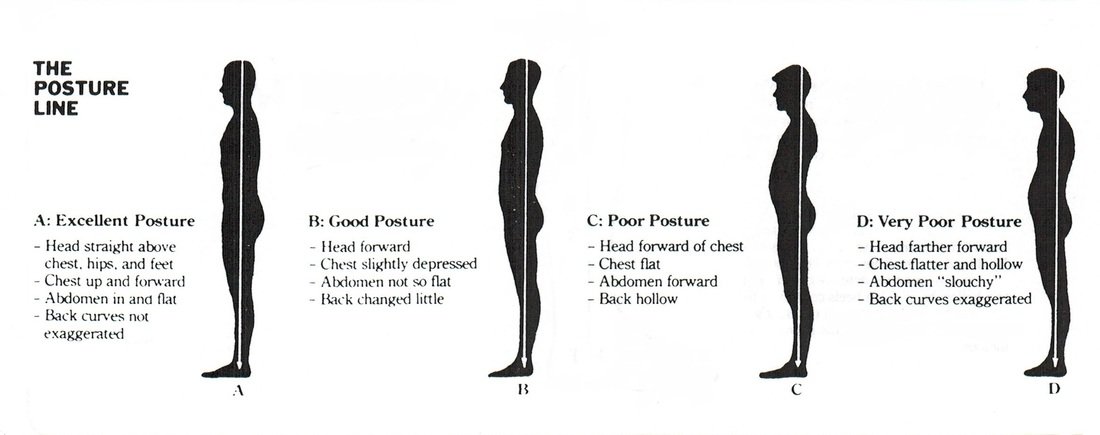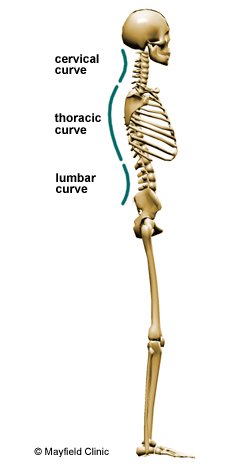UPright Posture
Why didn't I think of that?!?!?!?
Well, apparently other people have thought of it and there is actually more than one version of this device for sale on the internet (see infomercial below). These products are aimed at improving posture, and apparently there is a whole market of "wearable posture devices." I really missed the boat on this one.
What are these things really doing???
Well, they are just encouraging you to stay in a "normal" spinal alignment most of the time. As you can see from the diagram above it is best to have your head over your heels so that weight is distributed on both sides of the spinal column. With worse posture comes a more forward head position, meaning your posterior muscles (like the erector spinae) have to work harder to keep your head from falling forward. Instead of one big overload from lifting something too heavy for your spinal muscles to handle, this is more a cumulative damage from holding that 8lb bowling ball of a head from falling off that eventually causes neck and low back pain.
Of course, cell phones and computer screens are a big part of the forward head posture, but a bigger problem is just anything that keeps the spine in one postion too long. My presciption for poor posture is to move around more. I like the steading desk ideas and actually these little posture monitor, are nice reminders to keep moving.
I haven't done enough research to say these products work, but I can see the real purpose is to change that "C" curvature of the spine from sitting or standing slouched over a computer or phone to a proper slight "S" position of the spine to the right. As mentioned this puts the center of gravity of the head over the vertebral bodies of the cervical spine as well as the over the lumbar vertebral bodies which are normally in the center of the abdomen. The "spine" that you feel your back is really the spinous processes, not the actual weight bearing bones deep in the neck, chest, and abdomen.
So why the "S" shape?
We don't typically see buildings with columns shaped like the spinal column so what gives? While the beautiful Roman columns have been able to last centuries holding up the Coliseum, they aren't particularly good at movement. Your spinal column, on the other hand, will hold your body and head up for decades and yet be able to bend and twisting in countless directions. The "S" shape is a shock absorber to allow the spine to slightly compress under load without crumbling. It also allows the surrounding muscles to take some of the load by contracting. Therefore we can actually lift much more that just the vertebrae and their discs would allow.
If posture is important when sitting or standing for long periods of time, proper spinal alignment is even more important under large loads such as with deadlifts and squats. Don't neglect your spine when trying to work your legs, and don't bring your bad posture habits into the gym. The muscles surrounding the spine can move the body in many different positions but do not have the mechanical advantage of the lever joints. The best thing to do with heavy lifts, whether pressing or squating, sitting or standing, is to keep the spine in a "neutral" normal alignment with eyes up/level, chest out, and back in a slight curve. This maintains those curves in the cervical/thoracic/lumbar areas so that the spinal muscles only have to stabilize around the bone that can take the majority of the weight while the big muscles of the extremities actually moves the weight.
Of course, the the spine comes with a limit as to how much the spine should curve. Because of the ribs the thoracic spine is basically set with its kyphotic curve, but the cervical and lumbar vertebrae can have exagerations of their opposite curve called lordosis. There is a hyperlordosis of the low back and neck that are just as damaging long term if kept in this position. This is more of a rarity from overtraining the hip flexors that pull the anterior pelvis down, so while it's possible, it rarely affects the general population.
The final say in posture???
...is that there is no final, one-size-fits-all verdict when it comes to proper posture. There are hundreds of videos, websites, tips, and tricks to I could post, and many might be the latest snake oil on the market. Because each individual has a different body, genes, and job there are some things that will work for some people and not others. One thing that always helps is knowledge. The more you know about the way your body works the more you can diagnose and treat yourself before spending money on the latest fad.



